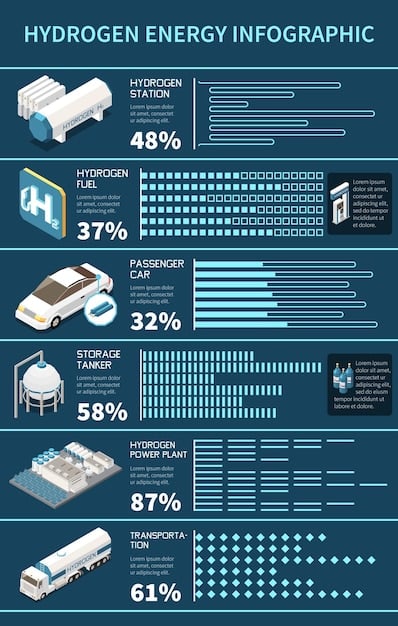Emerging Energy Storage Technologies: US Market Domination by 2030

By 2030, the US energy storage market will likely be dominated by advanced lithium-ion batteries, flow batteries for long-duration storage, solid-state batteries offering enhanced safety and energy density, and potentially hydrogen storage solutions as infrastructure develops to support renewable energy integration.
The energy landscape is rapidly evolving, and understanding what emerging energy storage technologies will dominate the US market by 2030 is crucial for investors, policymakers, and consumers alike. Innovation in this sector is driven by the rising demand for renewable energy integration and grid stabilization.
The Current State of Energy Storage in the US
Energy storage is no longer a futuristic concept; it’s a present-day necessity. Understanding the current landscape is crucial to predict future trends. We need to examine the existing players and technologies.
The US energy storage market is currently dominated by lithium-ion batteries, primarily used for short-duration storage applications such as frequency regulation and peak shaving. However, the need for longer-duration storage is growing, presenting opportunities for alternative technologies.
Several factors are driving the growth of energy storage, including:
- Increasing renewable energy penetration: Solar and wind power are intermittent, requiring storage to ensure a reliable electricity supply.
- Grid modernization efforts: Energy storage enhances grid stability and resilience.
- Declining storage costs: The cost of battery storage has decreased significantly, making it more economically viable.
Key Players in the Current Market
The current energy storage market is populated by several large and smaller players. These companies are either traditional battery manufacturers or new entrants into the market.
- Tesla: Leading manufacturer of lithium-ion batteries and energy storage systems.
- LG Chem: Another major player in lithium-ion battery production, with a strong presence in the residential and commercial storage markets.
- Fluence: A joint venture between Siemens and AES, focusing on grid-scale energy storage solutions.

The existing energy storage infrastructure provides a baseline as we look toward the energy storage technologies of the coming years. The existing tech is improving at a rapid rate and is very competitive.
Advanced Lithium-Ion Batteries
Lithium-ion technology continues to evolve, and advanced lithium-ion batteries will likely remain a dominant player in the energy storage market by 2030. Ongoing research and development are focused on enhancing energy density, safety, and cycle life.
Several innovations are poised to improve lithium-ion battery performance:
- Solid-state electrolytes: Replacing the liquid electrolyte with a solid-state material can improve safety and energy density.
- Silicon anodes: Using silicon instead of graphite as the anode material can increase energy density.
- Advanced cathode materials: Developing new cathode materials with higher energy density and stability.
The Role of Solid-State Batteries
Solid-state batteries are considered a game-changer in energy storage because they improve on some of the safety concerns with liquid electrolytes.
Solid-state batteries offer several advantages over conventional lithium-ion batteries:
- Enhanced safety: Solid electrolytes are non-flammable, reducing the risk of fire.
- Higher energy density: Solid electrolytes allow for the use of higher-energy electrode materials, increasing energy density.
- Improved cycle life: Solid-state batteries have the potential for longer cycle life compared to liquid electrolyte batteries.
However, significant challenges remain in the commercialization of solid-state batteries, including manufacturing scalability and cost reduction. As technology improves, costs should go down, making it more competitive.
Flow Batteries for Long-Duration Storage
Flow batteries are emerging as a promising solution for long-duration energy storage, addressing the limitations of lithium-ion batteries for applications requiring several hours of discharge time. In these systems, it is the amount of electrolyte that determines the amount of storage time, not the physical size of the battery cells.
Flow batteries offer several advantages:
- Scalability: The energy capacity of a flow battery can be easily scaled by increasing the size of the electrolyte tanks.
- Long cycle life: Flow batteries can withstand thousands of charge and discharge cycles without significant degradation.
- Independent power and energy: The power and energy ratings can be independently sized to meet specific application requirements.
Different Types of Flow Batteries
Several different chemistries are being developed for flow batteries, each with its own advantages and disadvantages.
- Vanadium redox flow batteries (VRFBs): The most mature flow battery technology, using vanadium electrolytes.
- Zinc-bromine flow batteries: Offering higher energy density but with challenges related to zinc dendrite formation.
- Organic flow batteries: Using organic electrolytes, potentially reducing costs and environmental impact.
Flow batteries are particularly well-suited for grid-scale energy storage applications, such as renewable energy integration and peak shaving. As grid storage grows, the costs will drop and these units should become a staple of grid operations.

Hydrogen Storage: A Potential Game Changer
Hydrogen storage is gaining attention as a potential long-term energy storage solution, particularly for applications requiring very long discharge durations (days or weeks). Its development is linked to the expansion of green hydrogen production.
Hydrogen offers several advantages as an energy storage medium:
- High energy density: Hydrogen has a high energy density by mass, making it suitable for long-duration storage.
- Versatility: Hydrogen can be used for various applications, including electricity generation, transportation, and industrial processes.
- Renewable energy integration: Hydrogen can be produced from renewable energy sources through electrolysis.
Challenges and Opportunities for Hydrogen Storage
Despite its potential, hydrogen storage faces significant challenges.
- Cost: Production, storage, and transportation of hydrogen are currently expensive.
- Infrastructure: A hydrogen infrastructure, including pipelines and refueling stations, is needed for widespread adoption.
- Safety: Hydrogen is flammable and requires safe handling and storage procedures.
Government incentives, technological breakthroughs, and infrastructure development will be critical to the widespread adoption of hydrogen storage.
The Role of Government Policies and Incentives
Government policies and incentives play a crucial role in accelerating the deployment of emerging energy storage technologies. These policies can help reduce costs, encourage innovation, and create a level playing field for new technologies.
Key policies and incentives include:
- Investment tax credits (ITCs): Providing tax credits for energy storage projects.
- Direct subsidies: Providing financial support for research, development, and deployment of energy storage technologies.
- Renewable portfolio standards (RPS): Requiring utilities to incorporate energy storage into their renewable energy plans.
The Impact of the Inflation Reduction Act
The Inflation Reduction Act (IRA) of 2022 includes significant incentives for energy storage, which are expected to drive substantial growth in the market.
The IRA’s provisions include:
- Extension and expansion of the ITC: Providing a 30% tax credit for energy storage projects.
- Direct pay option: Allowing tax-exempt entities to receive direct payments instead of tax credits.
- Incentives for domestic manufacturing: Supporting the development of a domestic energy storage supply chain.
The IRA is expected to significantly lower the cost of energy storage, making it more competitive with traditional energy sources and accelerating its deployment.
Economic Viability and Cost Trends
The economic viability of emerging energy storage technologies is a critical factor in determining their market dominance. Cost reductions, improved performance, and supportive policies are essential for widespread adoption.
Current cost trends:
- Lithium-ion batteries: Costs have declined significantly over the past decade, but further reductions are needed for long-duration storage applications.
- Flow batteries: Costs are higher than lithium-ion batteries but are expected to decline as manufacturing capacity increases.
- Hydrogen storage: Costs are currently high but could decrease with technological advancements and infrastructure development.
Future Cost Projections
Several factors will influence the future cost of energy storage technologies:
- Technological innovation: Breakthroughs in materials science, manufacturing processes, and system design.
- Economies of scale: Increased production volumes leading to lower manufacturing costs.
- Supply chain development: Building a robust and competitive supply chain for energy storage components.
As costs decline and performance improves, emerging energy storage technologies will become increasingly competitive and play a larger role in the US energy market.
| Key Technology | Brief Description |
|---|---|
| ⚡ Lithium-Ion | Dominant now, improving on safety and energy levels. |
| 🌊 Flow Batteries | Great for long durations, scalable, and can work for decades. |
| 🔋 Solid-State | Safer with more energy, but still in development. |
| 💨 Hydrogen | Long-term potential, needs more infrastructure to be useful. |
FAQ
Emerging energy storage technologies offer benefits like improved grid reliability, integration of renewable energy, and reduced dependence on fossil fuels. Ultimately, those are the driving factors for storage growth.
The Inflation Reduction Act provides significant incentives for energy storage, including tax credits and direct pay options, driving down costs and accelerating deployment across the country.
Challenges include the high costs of hydrogen production, storage, and transportation, as well as the need for new infrastructure. There are also concerns about the flammability of the gas.
Yes, flow batteries are well-suited for grid-scale energy storage due to their scalability, long cycle life, and ability to independently size power and energy ratings. They can be made quite large for grid use.
Energy storage helps to address the intermittency of renewable energy sources like solar and wind, ensuring a reliable and consistent electricity supply, regardless of weather conditions. This is vital.
Conclusion
By 2030, the US energy storage market will be a dynamic mix of established and emerging technologies. Advanced lithium-ion batteries will continue to play a significant role, while flow batteries, solid-state batteries, and hydrogen storage solutions will gain traction. Government policies, technological advancements, and cost reductions will be critical drivers of market growth, shaping a more resilient and sustainable energy future.




